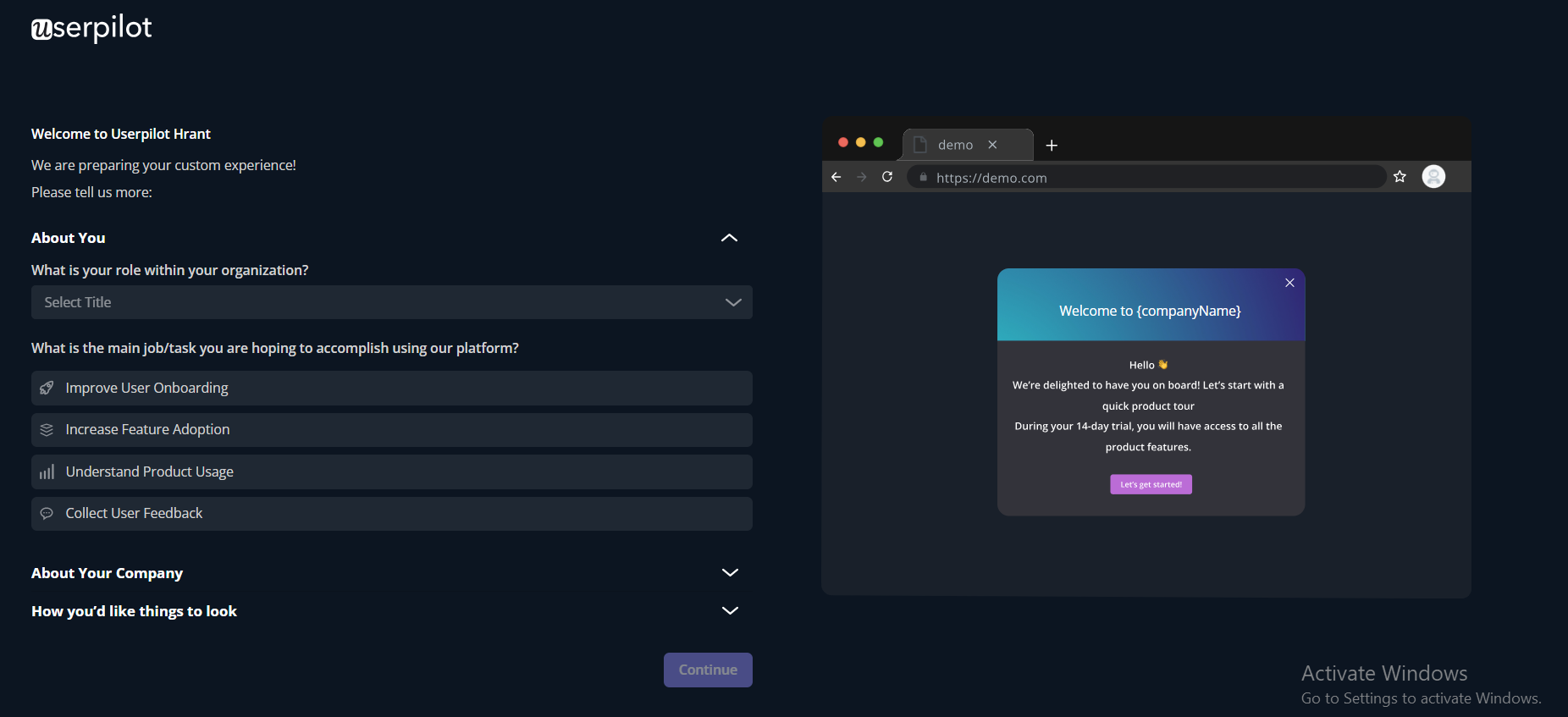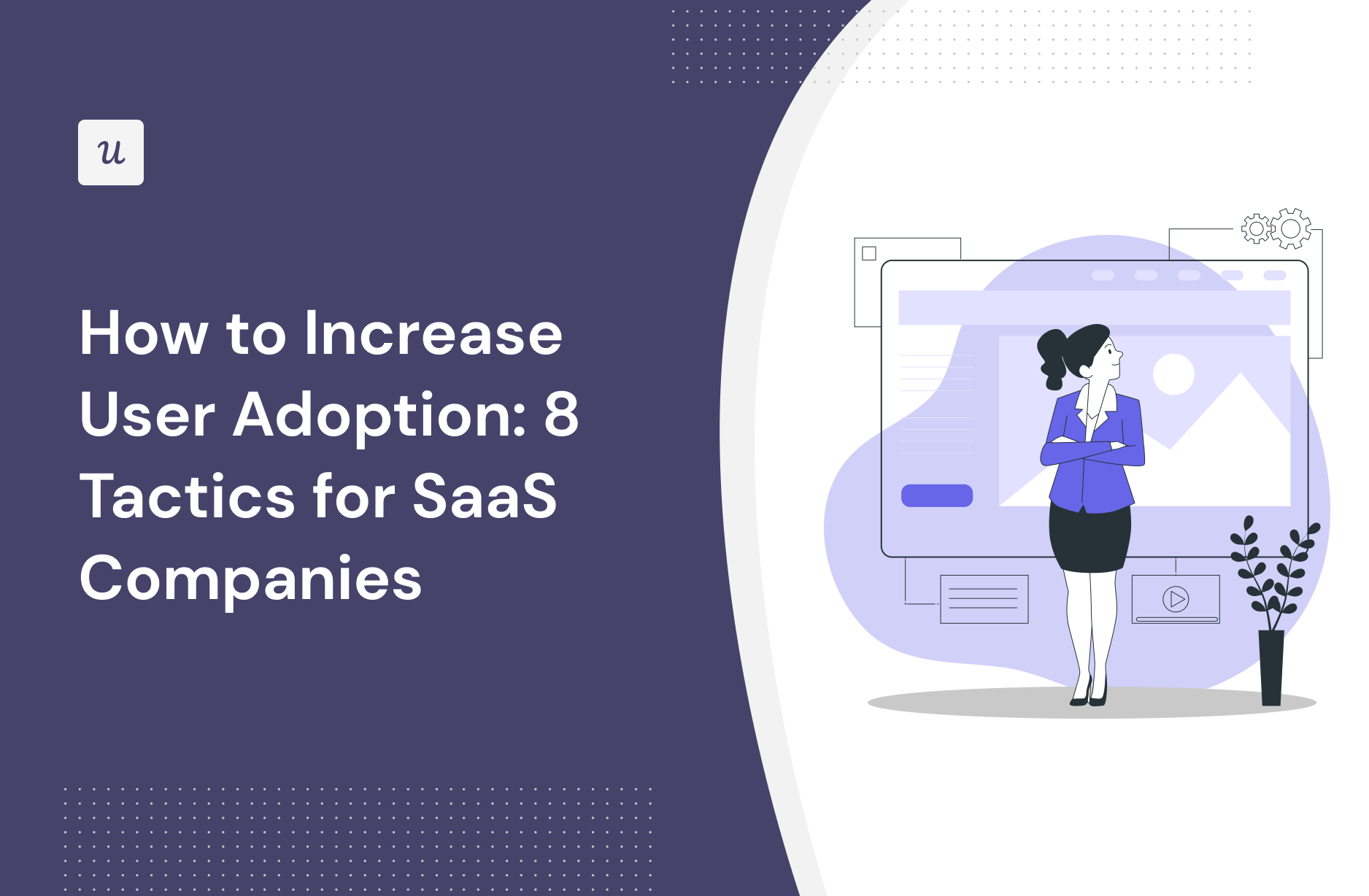
When working with SaaS products, a constant task you’ll find yourself obsessed with is how to increase user adoption.
Let’s assume your tool helps the user easily schedule work meetings. You’ll have a bunch of features that help them do this, eg a calendar, invite/share link feature, etc. User adoption is how you measure how much of your product the user is regularly using.
The more features they use, the more value they get from your product, and the higher retention and user adoption rate.
In this blog post, we’re going to learn 8 tested user adoption strategies for SaaS companies including real-life examples. Let’s get started!
Try Userpilot Now
See Why 1,000+ Teams Choose Userpilot

Summary of how to increase user adoption
- The user adoption process refers to how many of the users who sign up for your product, use it and the features relevant to them.
- User adoption rate is an important metric for most SaaS companies as they rely on continuous payments/renewed subscriptions to stay in business.
- To improve user adoption, you must consider every part of the customer journey. Activation, which is the point where a new user has used a feature and gotten value from it, is key to achieving high user adoption rates.
- If existing customers aren’t getting a positive impact and adopting your product then it doesn’t matter how many new users sign up, you’ll always have a low user adoption rate.
- Your user adoption strategies should be focused on fixing the biggest barriers to adoption in your customer funnel, that’s how you’ll get the highest potential ROI.
- Strategies for User Adoption:
- Optimize Onboarding: Make the signup process quick and easy.
- Secondary Onboarding: Introduce advanced features through checklists.
- In-App Guidance: Use interactive walkthroughs to teach users.
- In-App Announcements: Inform users about new features.
- Gather Feedback: Use micro-surveys to improve the product.
- Self-Service Support: Offer resources for problem-solving.
- Ongoing Engagement: Continually engage users to maintain adoption.
- Constantly measure user adoption.
- Implement adoption strategies with Userpilot. Book a demo to learn more!
What is user adoption?
User adoption simply indicates product usage i.e. how many users frequently use the product feature most relevant to their use case. It’s how you quantify the percentage of existing users who have adopted the different features of your product.
Let’s assume you have invoicing software that serves both freelancers and vendors. You can calculate the user adoption rate for these two different segments separately, and based on the features most relevant to their experience.
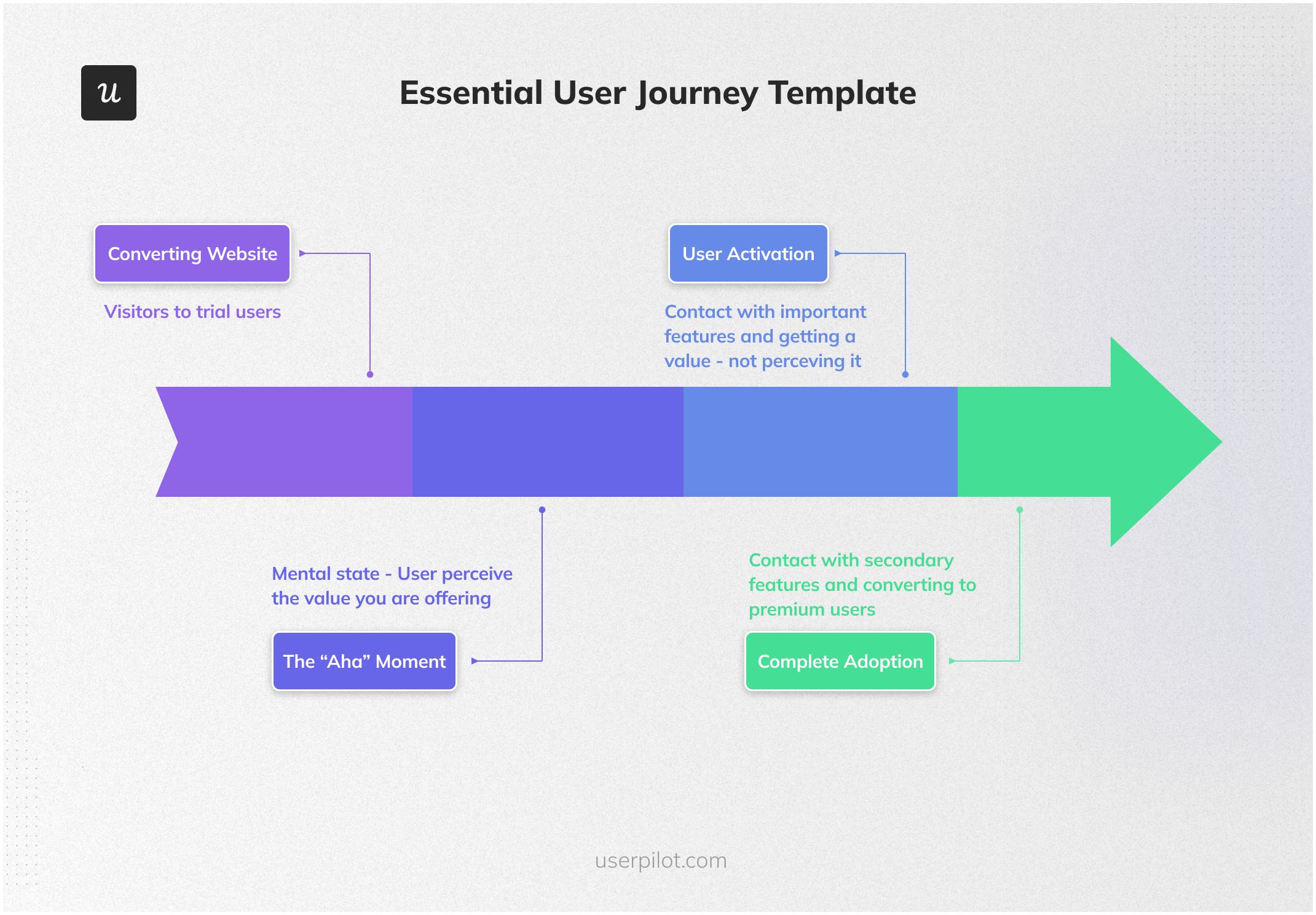
Why is user adoption important?
Churn is the enemy of SaaS businesses. So if user adoption is how much your users are adopting the features of your product, it makes the most sense to focus on strategies that’ll increase your user adoption rates and lower churn.
To improve user adoption, each stage of the funnel must be optimized to encourage customers to keep discovering and using your tool.
As SaaS businesses run on subscriptions or repeated usage to make a profit, simply acquiring more users isn’t enough. Driving them to the point where they’re actively choosing your product as a solution aka user adoption, is how you stay in business.
A successful user adoption strategy doesn’t only increase customer lifetime value but also improves the user onboarding process.
What part does user activation play in your user adoption strategy?
As mentioned above, user adoption is a gradual process that happens across all steps of the customer journey after new users sign up for your product.
New users go through different stages before eventually reaching full adoption. We call this the adoption flywheel.
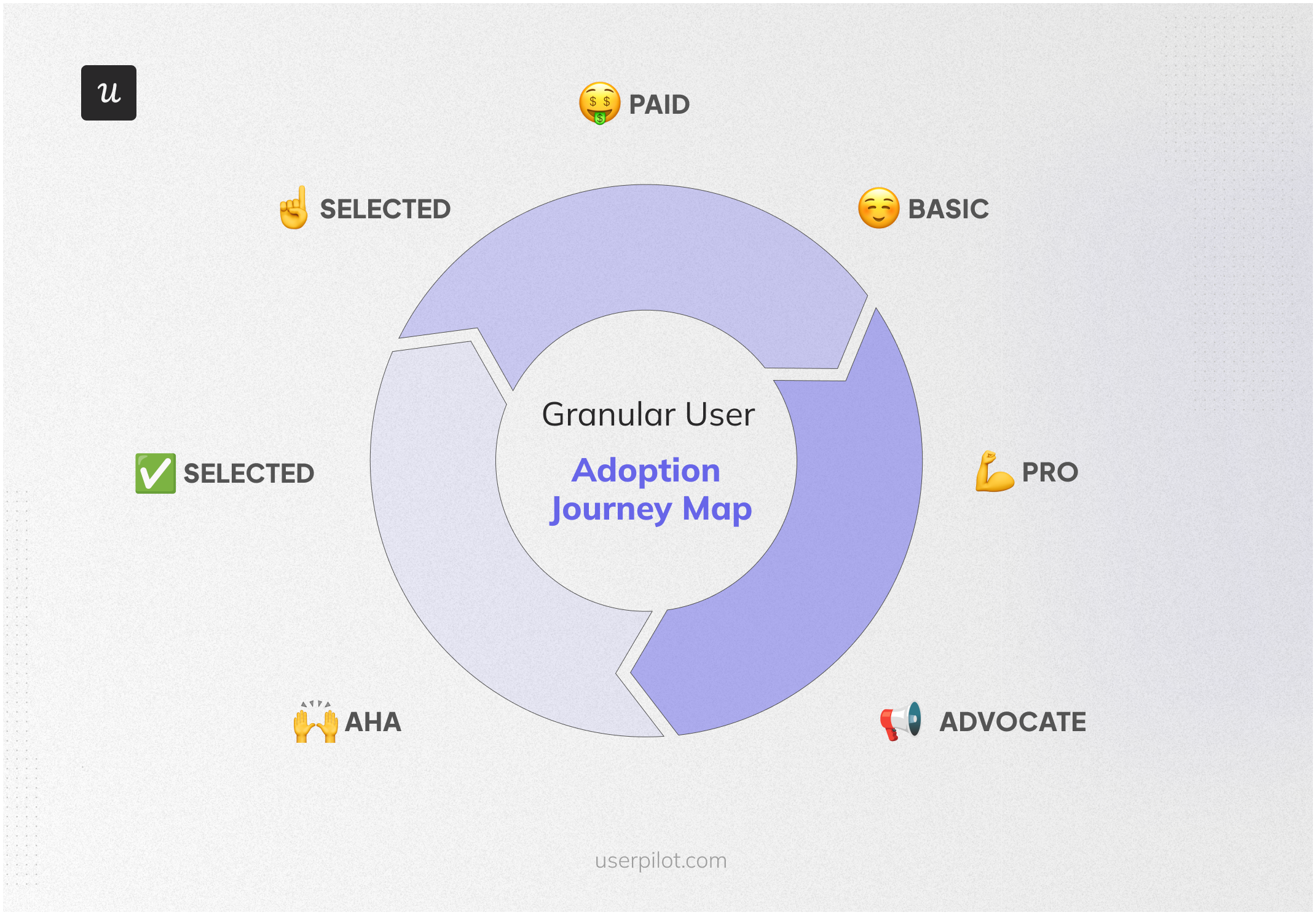
This journey starts with the ‘aha moment’ when a new user recognizes your product as a potential solution to their problem. Activation, on the other hand, happens after they’ve tried out different features of your product and gotten value from it.
User adoption isn’t possible if your users are not reaching the activation stage. If you’re attracting 1,000 prospects monthly but only 200 of them see value in your product, a user adoption strategy may not be your immediate goal. Focusing on increasing activation improves your chances of reaching high user adoption rates.
8 Best user adoption strategies
Applying best practices for the sake of it is never the best strategy. A good user adoption strategy looks at every stage of the customer journey and puts in place, tactics to help optimize problem areas and improve user adoption.
If you already have a strategy but looking for tactics ideas, here are the most important ones that you should look into.
#1: Drive users to the activation point by optimizing your onboarding process
We’ve already established that getting your customers to the activation point increases the likelihood of user adoption success. This is what a good primary onboarding process is all about – quickly getting users to activation.
Here are some best practices for product-led companies:
- You want to get new users into your app, so your signup flow should be as quick and easy as possible.
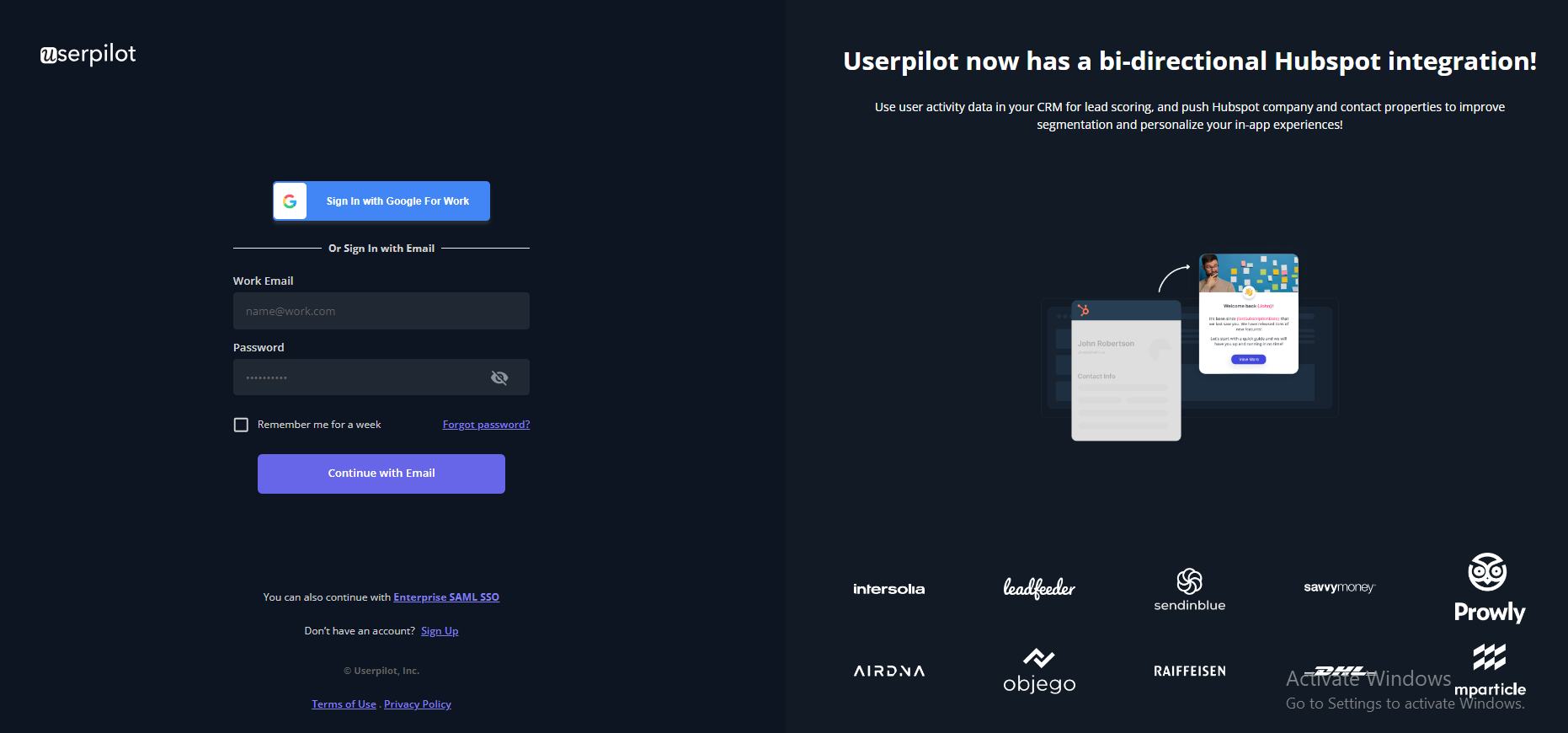
- Create mobile onboarding flows, customizing welcome screens, carousels, and slideouts to deliver personalized messaging.
- Replace empty states with personalized content to help users understand the value of your product faster.
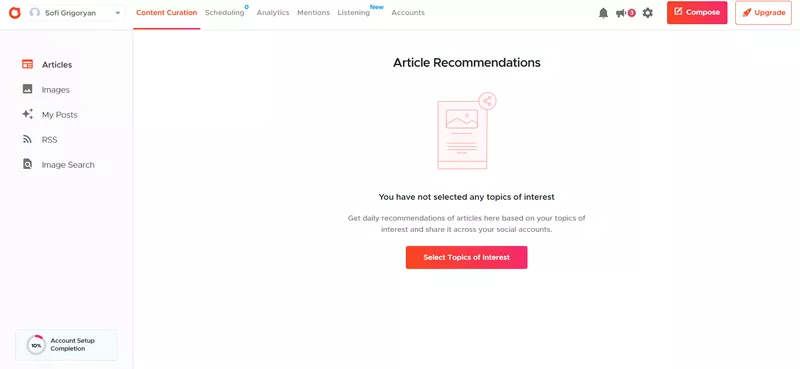
- Use tooltips, checklists, guides, and other UI patterns to shorten the learning curve and guide users toward the activation point.
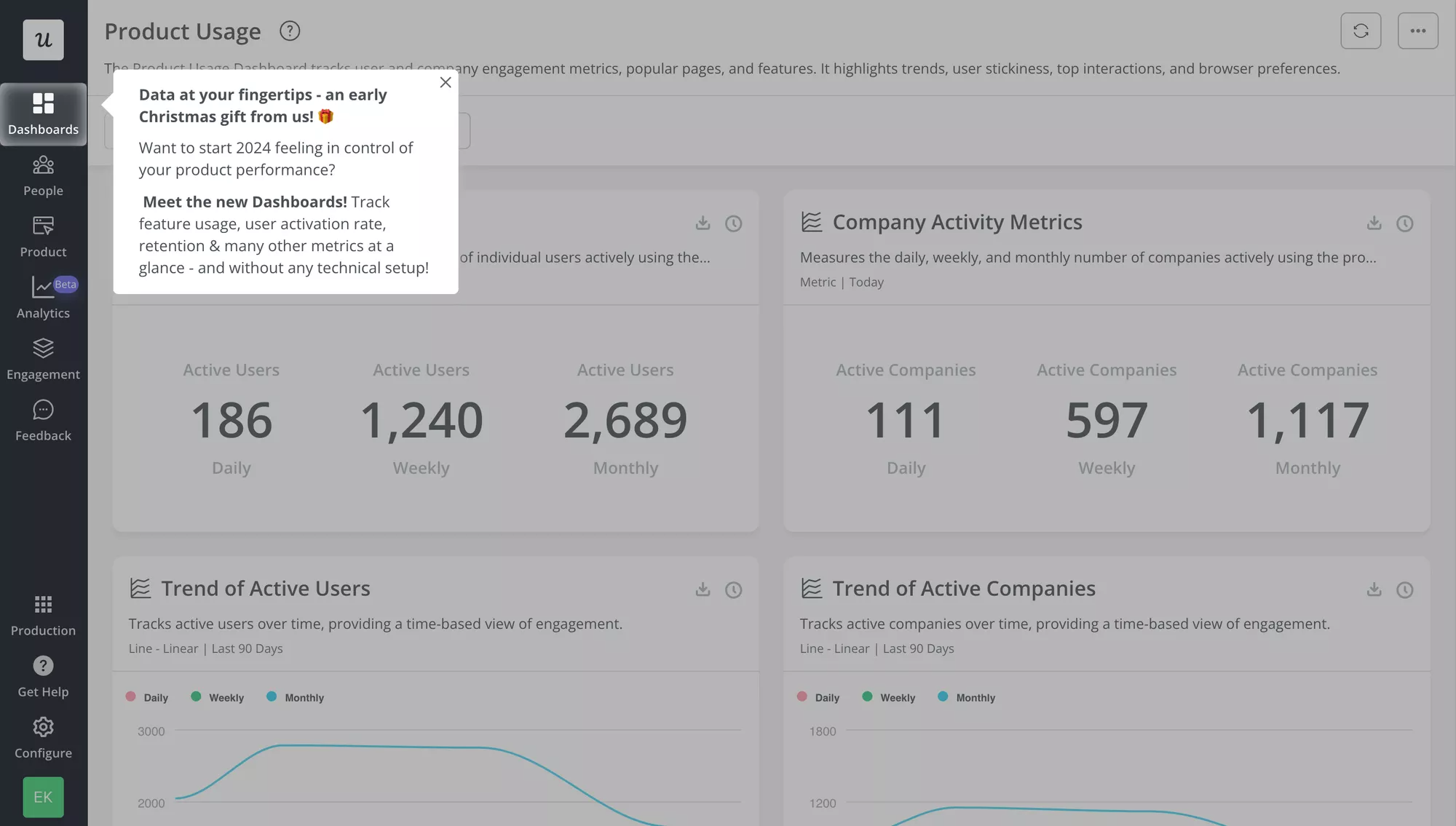
- Use welcome screens to learn more about your user and personalize their journey inside the product based on their needs.
How to collect data
#2: Increase user adoption rate with secondary onboarding checklists
Low user adoption rates can result in churn so you should do everything in your power to improve adoption metrics.
One way to do it is with onboarding checklists.
Secondary onboarding checklists help by introducing users to more relevant features that let them get more value from your product.
Users adopt tools faster when they’re able to complete their goals with them. So based on the things customers use your product for, you should highlight the more advanced features that will bring extra value.
Use in-app checklists to prompt users to discover and adopt advanced features.
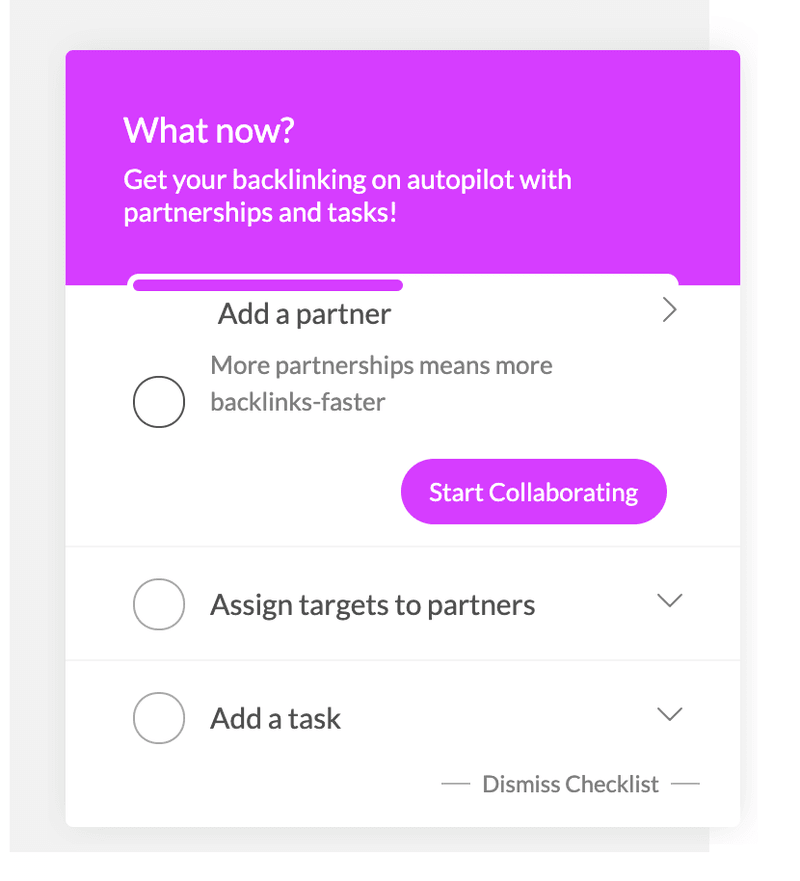
#3: Boost product adoption with in-app guidance
Sometimes, the best way to get users to quickly adopt your product’s features is by teaching them how to use it. Think of interactive walkthroughs as training modules for new customers, especially if your SaaS product has a steeper learning curve.
Interactive walkthroughs are a series of tooltips that guide the user step by step to using a feature for the first time. This shortens the learning path and delivers value faster. With these walkthroughs, you can reduce the effort and time a user will spend trying to figure things out on their own and even increase user engagement.
You can build in-app guides that walk the user step by step in engaging with your product, don’t just give them a list of tasks to do (checklist), show them how to complete each one. You can also pair your interactive walkthrough with your onboarding checklists.
Here’s an example of a short interactive walkthrough. Kommunicate guides users on how to personalize their chatbot for the first time using a series of tooltips that trigger one after another
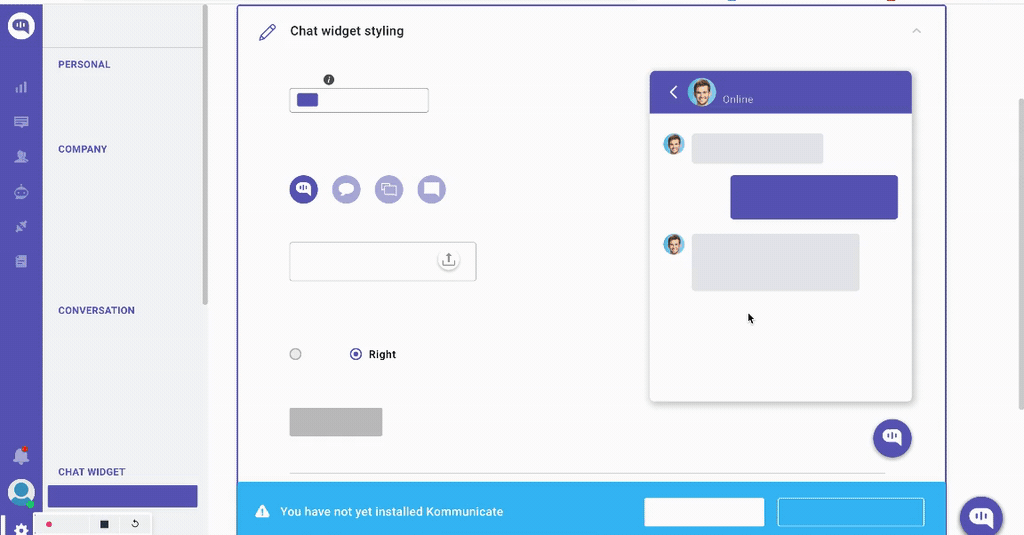
#4: Increase new feature adoption with in-app announcements
Users typically don’t navigate your product expecting or looking for new features, that’s why once a new feature is launched, you should let them know. In-app messages are a great way to let them know of a new feature that’s relevant to them.
Slideouts are great for announcing new features because they’re not intrusive and can give enough details to get users started.
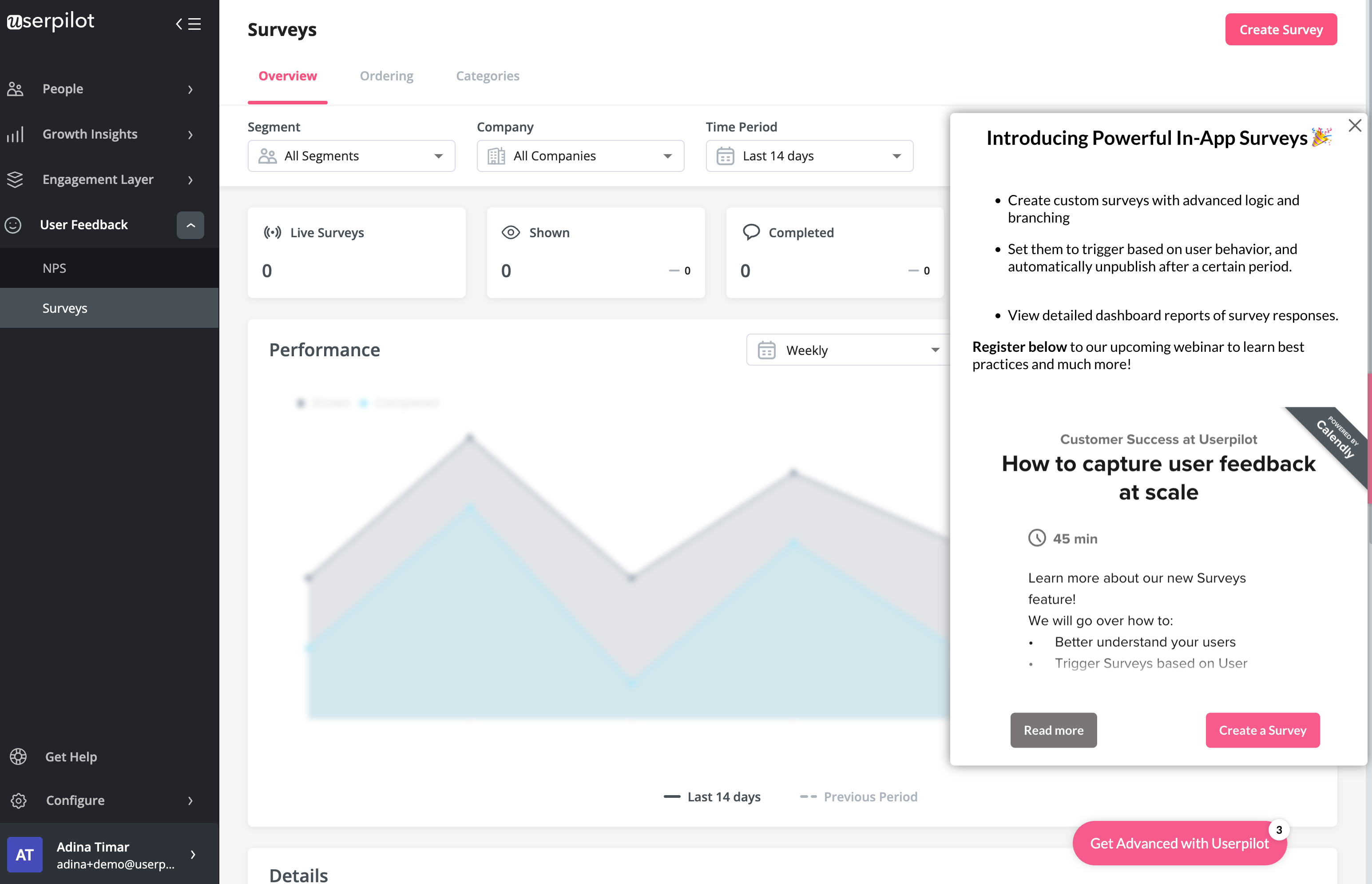
For best results, use segmentation so each in-app message only goes out to individual users who’ll benefit from it.
#5: Gather user feedback to boost product adoption
Use in-app micro surveys to collect customer feedback. From the quantitative and qualitative data you get, you can then learn how to:
- Improve your product’s features and usability.
- Discover the friction points in your app, and remove them.
- Help customer success teams understand where users struggle.
You can also use different customer satisfaction surveys at different times of the user journey.
For example, after they’ve engaged with a new feature find out how their experience was and what they liked or what’s stopping them from fully adopting the feature.
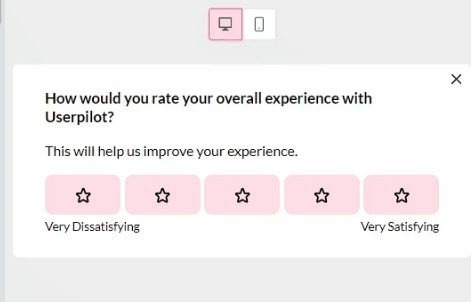
#6: Offer self-service support for a better customer experience
If 81% of your customers will attempt to solve a problem by themselves before reaching out to support staff, it only makes sense that you offer them self-service support. This could be in the form of an in-app resource center, knowledge bases, or chatbots that show up only at the points where they may need them.
This self-service support helps improve adoption rates because once customers can easily access the solution to their problem/encountered friction, they can be on their way to getting more value from your product and then fully adopting it.
If users have to always call or email the customer support team before they can get things sorted in-app, many will rather just abandon your product for a competitor’s product. This then leads to a low user adoption rate.
Your resource center can include your in-app guides, links to documentation articles, a 1-click get in touch chat launcher, etc.
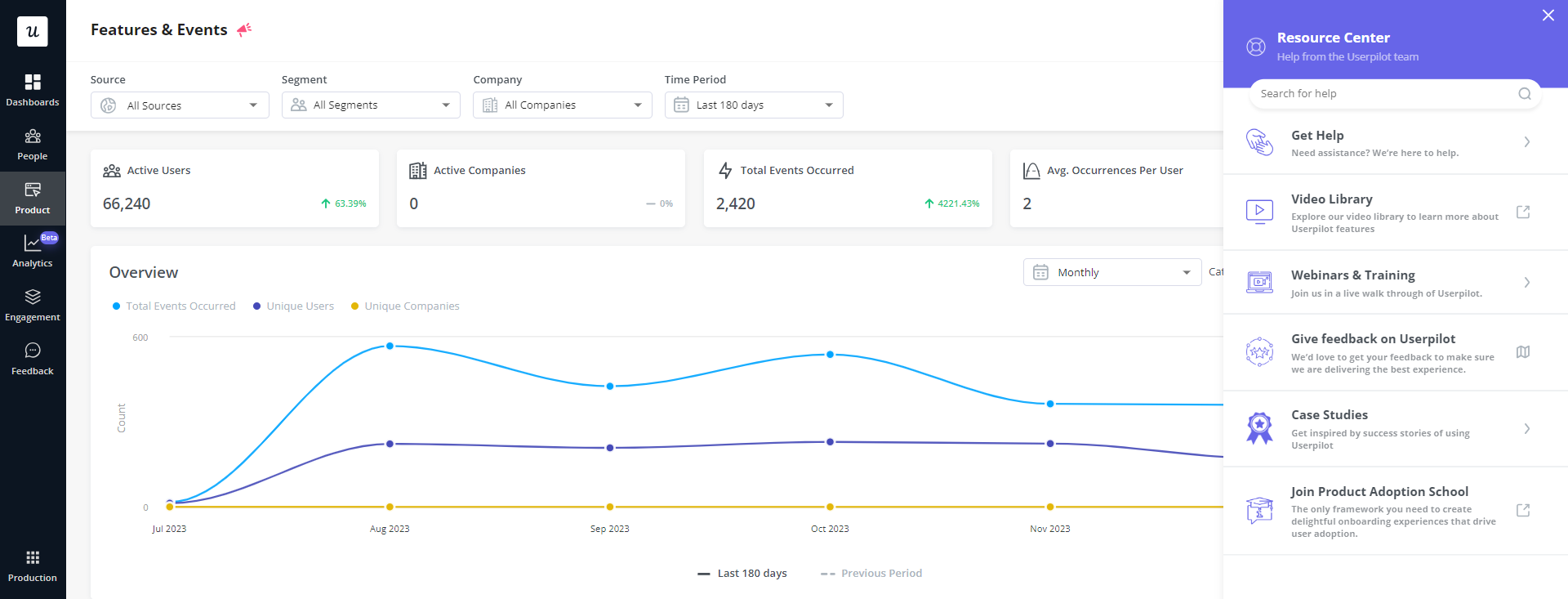
#7: Make user adoption an ongoing process
From when a user signs up till they end their business, the adoption process never ends.
New customers and existing customers need to constantly engage with your product and get value from it. This is the only way they can meet the several activation criteria, keep paying their subscription fees, and reach product adoption.
You need to constantly:
- Give them reasons to stick to your product.
- Make sure their experience is as frictionless as possible.
- Listen to their voice and concerns and act on them to improve your product and experience.
#8: Measure user adoption success with user adoption metrics
Measuring user adoption success is crucial for businesses and organizations to ensure their products or services are being effectively utilized and to track the overall health of their customer base.
User adoption metrics provide valuable insights into how well users are engaging with a product, service, or platform. Here are some of the metrics you need to track:
- Monthly active users (MAU): Tracking MAU helps assess the overall popularity and ongoing relevance of a product. A consistent increase in MAU indicates growing user adoption, while a decline may signify issues with user retention or competition.
- User activation rate: The activation rate measures the percentage of new users who complete specific actions or milestones that indicate they have fully onboarded and are actively using the product. A high activation rate suggests that users are finding value in the product quickly and are more likely to continue using it. This metric helps identify any onboarding bottlenecks or areas that require improvement.
- Customer lifetime value (CLTV): CLTV is a crucial metric for assessing the long-term profitability of user adoption. It helps in making informed decisions about customer acquisition costs and retention strategies. A higher CLTV implies better user adoption and customer satisfaction.
- Customer retention rate: Customer retention rate measures the percentage of customers who continue to use a product or service over a specified period. A high retention rate indicates strong user adoption because it reflects users’ ongoing satisfaction and loyalty. A low retention rate may signify issues with the product, customer support, or competitive pressures.
- Customer churn rate: The churn rate is the flip side of the retention rate. A high churn rate can be detrimental to user adoption and a business’s sustainability. Monitoring and reducing churn is essential for maintaining a healthy customer base.
In summary, user adoption metrics are critical for understanding how well a product or service is being embraced by users, whether they are new or existing customers.
By regularly tracking and analyzing these metrics, businesses can identify areas for improvement, make data-driven decisions, and ultimately enhance the overall user experience, which can lead to greater success and profitability.
Conclusion
Increasing user adoption is not just a continuous process, it’s also one that concerns entire departments of your company. From company leaders to the sales team and all other team members, the goal of all business processes should be how to get your end-users to choose your product over and over again.
Product-led growth will only be achieved when product adoption/user adoption rates are improving. That’s why the user adoption strategies covered in this article should be included in your business.
Want to know how to increase user adoption from the onboarding process and beyond with a code-free product adoption tool? Book a demo call with our team and get started!
Try Userpilot and Take Your User Adoption to the Next Level


